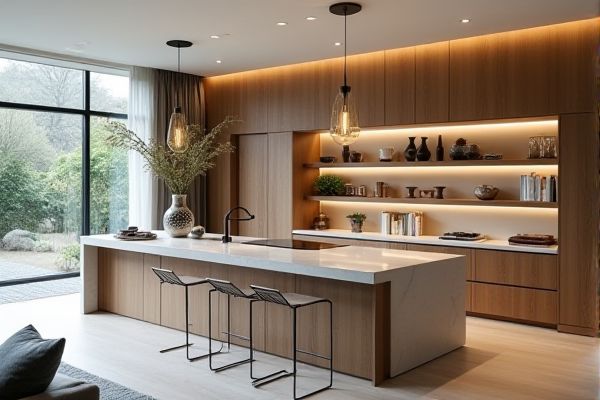
Waterfall edge shelving features a smooth, continuous curve that extends from the shelf surface down to the front edge, providing a sleek and modern look while enhancing durability by reducing potential damage points. You'll find the rest of the article explores how this design compares to standard edge shelving in terms of aesthetics, strength, and installation options.
Table of Comparison
| Feature | Waterfall Edge Shelving | Standard Edge Shelving |
|---|---|---|
| Design | Curved front edge for seamless flow | Straight, angular front edge |
| Safety | Rounded edges reduce injury risk | Sharp edges may increase injury risk |
| Aesthetic Appeal | Modern, sleek appearance | Traditional, utilitarian look |
| Material Use | Requires flexible or layered materials | Uses standard, flat materials |
| Cost | Generally higher due to design complexity | More cost-effective and easier to produce |
| Durability | Durable with proper material and finish | Standard durability based on material quality |
| Installation | May require specialized installation | Standard installation process |
Introduction to Waterfall Edge Shelving and Standard Edge Shelving
Waterfall edge shelving features a continuous surface where the shelf material flows seamlessly over the edge, creating a sleek and modern look that enhances durability by protecting against chips and wear. Standard edge shelving has a distinct, often squared or rounded edge, which can be more prone to damage but offers a classic appearance suitable for traditional designs. Choosing between waterfall and standard edge shelving depends on your aesthetic preference and the level of durability you require for your space.
Design Differences Between Waterfall and Standard Edge Shelving
Waterfall edge shelving features a continuous, seamless surface where the top shelf material flows vertically down the sides, creating a sleek and modern look. Standard edge shelving typically uses separate trim or banding around the edges, resulting in visible seams and a more traditional appearance. This design difference not only affects aesthetics but also impacts durability and ease of cleaning, with waterfall edges offering enhanced protection against moisture and debris.
Aesthetic Appeal: Waterfall Edge vs Standard Edge
Waterfall edge shelving offers a sleek, modern aesthetic with its continuous, flowing lines that seamlessly extend over the shelf edges, enhancing visual depth and sophistication. In contrast, standard edge shelving features straight, clean cuts that prioritize simplicity and functionality, providing a classic, understated look. The waterfall edge's smooth curves create a striking design statement, while the standard edge maintains a minimalist appeal suitable for versatile interior styles.
Durability and Material Comparison
Waterfall edge shelving features a continuous design where the material folds down the sides, enhancing structural integrity and reducing the risk of chipping compared to standard edge shelving with separate edge banding. Typically fabricated from solid wood or high-grade engineered materials, waterfall edges resist wear and moisture penetration more effectively, extending shelf lifespan in high-traffic areas. Standard edge shelving often uses thinner veneers or edge bands that can delaminate or crack over time, making waterfall edges preferable for durability-intensive applications.
Functional Benefits of Waterfall Edge Shelving
Waterfall edge shelving offers enhanced durability and stability due to its continuous bend from the shelf surface down the edge, reducing the risk of chipping and increasing load-bearing capacity compared to standard edge shelving. This design also facilitates easier cleaning and maintenance by minimizing sharp edges and corners where dust and debris commonly accumulate. The seamless transition of waterfall edges improves safety by eliminating exposed sharp edges, making it ideal for high-traffic or commercial environments.
Installation Process: Waterfall Edge vs Standard Edge
Waterfall edge shelving requires precise fabrication and seamless corner alignment to create a continuous, flowing look, making the installation process more detailed and time-consuming compared to standard edge shelving. Standard edge shelving involves straightforward cutting and finishing, allowing quicker installation with fewer specialized skills or tools. The waterfall edge demands professional expertise to ensure structural integrity and aesthetic continuity, while standard edges offer greater flexibility and ease for DIY installations.
Cost Comparison: Which Option Is More Budget-Friendly?
Waterfall edge shelving typically costs more than standard edge shelving due to the added material and craftsmanship required for the seamless continuation of the countertop material down the sides. Standard edge shelving offers a more budget-friendly alternative by using simpler cuts and less material, reducing overall expenses. For cost-conscious projects, standard edge shelving provides an economical solution without compromising basic functionality.
Maintenance and Cleaning Considerations
Waterfall edge shelving offers easier maintenance because its continuous surface prevents dirt and grime from accumulating in seams or gaps, unlike standard edge shelving which often has crevices that trap dust and require more frequent detailed cleaning. The seamless design of waterfall edges minimizes the need for harsh cleaning chemicals, helping preserve the material's finish and longevity. For your space, choosing waterfall edge shelving can reduce cleaning time and effort while maintaining a pristine appearance.
Best Applications for Each Shelving Type
Waterfall edge shelving excels in retail environments where product visibility and aesthetic appeal are paramount, such as clothing stores and high-end boutiques, because its curved front edge allows items to be displayed more prominently. Standard edge shelving is ideal for general storage and utility settings like warehouses and libraries, offering durability and maximizing space efficiency without emphasis on visual presentation. Selecting the appropriate shelving depends on balancing the need for display attractiveness with functional storage capacity.
Conclusion: Choosing the Right Edge Shelving for Your Space
Waterfall edge shelving offers a sleek, modern aesthetic with seamless, continuous lines that enhance minimalist interiors and maximize visual flow. Standard edge shelving provides versatile options with defined contours, often boasting greater durability and ease of installation suited for traditional or industrial designs. Selecting the right edge shelving depends on balancing stylistic preferences, functional needs, and the overall design theme of your space.
 homyna.com
homyna.com